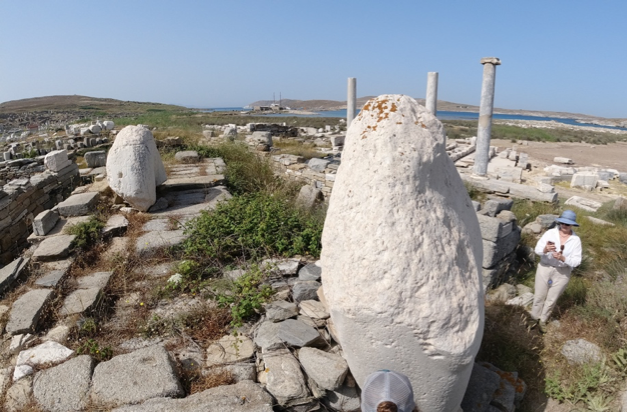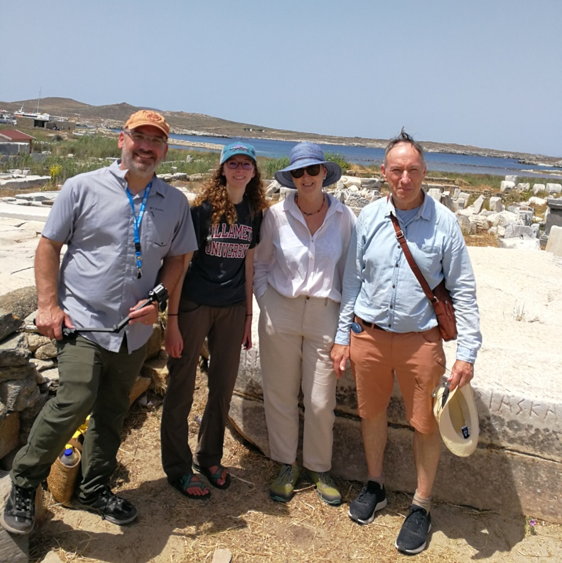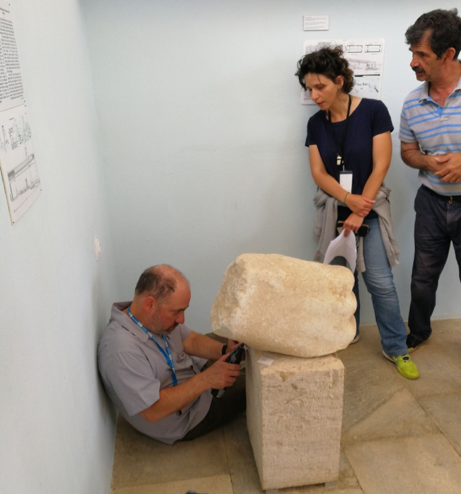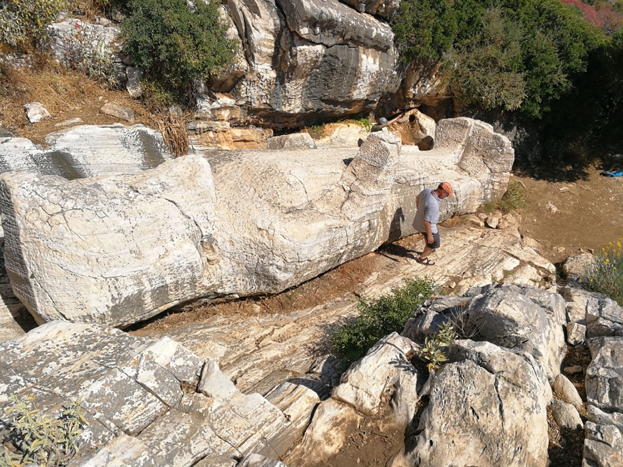It is believed to be the largest surviving Greek statue: 30 tons of white marble, standing at an estimated 22 metres tall. The figure of Apollo, holding a bow in one hand and the three Graces in the other, is one of the earliest examples of monumental marble sculpture in Europe, having been carved around 600 BC.
Even with the surviving huge torso split in two, the statue is one of the most dramatic sights on the Aegean island of Delos.
Figure 1: The Colossus of Naxos on Delos (lower and upper torso).
Associate Professor Kenneth Sheedy from the Department of Ancient History has been on a 20-year quest to find this impressive statue’s origins. The quarry at which this and the other colossal statues dedicated to Apollo on the island were carved has never been identified.
“If we could locate the quarry in which the colossal statues on Delos were carved then we might claim to have found one of the earliest quarries for monumental sculpture in Europe, and arguably the very first,” says Sheedy.
“The Naxians evidently pioneered the introduction of marble sculpture in Greece perhaps beginning around 650 BC, thus launching an artistic tradition in Europe which continues until today.”

Figure 2: Project team from left, S. Pike, Elaina, B. Menadier and K Sheedy, standing in front of statue base
The statue’s separate base carries an inscription on one side announcing: ‘I am of the same stone, statue and base’, and on another side a later inscription ‘From the Naxians to Apollo’. As a result, it is popularly known as the ‘Colossus of the Naxians’.
Various fragments, including two left hands, have all been attributed to the same statue, leaving the project team to uncover which fragments belong together, and where the marble was quarried.
“Despite the claim of the inscription that base and statue were of the same stone, it is not clear what this means,” says Sheedy.
“The combined weight of base and statue might reach 60 tons. Were they carved from the same block of marble? Are we to understand instead that the stone is from the same quarry, or simply from the same island?
Work on the project began as far back as 1998 when Sheedy, then a curator at the British Museum, began studies of the fragment of a base and foot in the Museum storerooms attributed to the colossus.
Stable isotope analysis was carried out by his collaborator Scott Pike from the Department of Environmental and Earth Sciences at Willamette University, Oregon. This proven technique measures the stable isotope ratios of the marble and compares the results to an internationally recognized database of the important ancient marble producing quarries in the eastern Mediterranean basin.
The results pointed to south-east Naxos. Although the Department of Antiquities for the Greek islands, the Cyclades, was willing to support a proposed program for the analysis on all surviving fragments from the statues, a newly implemented policy by the Hellenic Ministry for Culture prevented all destructive methods of analysis, such as those – like stable isotope analysis – requiring drilling.
But in 2018 the moratorium was lifted. Sheedy and Pike were given permission to sample the statue fragments, and then to undertake a search for ancient marble quarries on Naxos.
In June this year, they resumed their work on Delos by taking samples from the five known fragments of Apollo for the purpose of stable isotope analysis. Pike worked with a hand-held drill, under supervision from the museum staff, drilling only in areas where there was no trace of an original surface (eg in a break), carefully removing surface stone which was contaminated by the environment and then collecting marble dust from the drill head as it moved deeper into the stone.
 Figure 3: Scott Pike drilling one of the colossal hands, which once held a metal bow.
Figure 3: Scott Pike drilling one of the colossal hands, which once held a metal bow.
From Delos, Sheedy and Pike travelled to Naxos, the island on which we believed the colossus was carved. They visited the island’s known ancient marble quarries as well as modern quarries to understand the geology of Naxos and in particular the pattern of white marble distribution.
From here they focused their attention on the south-east region of the island searching for outcrops of quality white marble that may have been used for the sculpture.
“Our immediate problem was clear: there were no known marble sources let alone ancient quarries in this region, and there was almost no sign of ancient habitation from the archaic period in which Naxian sculptors had been at work,” says Sheedy.
“But with patience and a good deal of walking we did indeed spot white marble outcrops that had been previous overlooked.

Figure 4: Statue in ancient quarry on Naxos
“Now we have a nervous wait. All of the marble samples are with a laboratory in Oregon – and the results are expected by October. We have no doubt that the new information will significantly change the way in which the colossal statues of Apollo on Delos are studied.”
This project was made possible by supporting funds from the Kress Foundation in the USA and from the Faculty of Arts at Macquarie University.